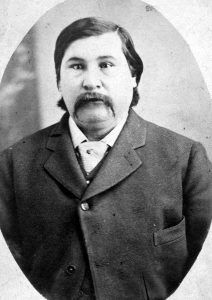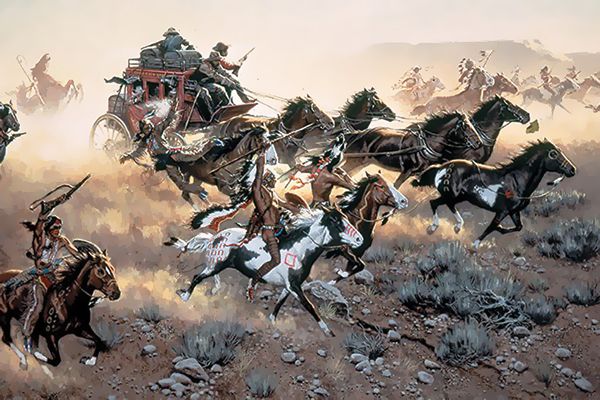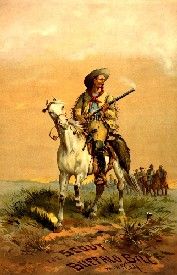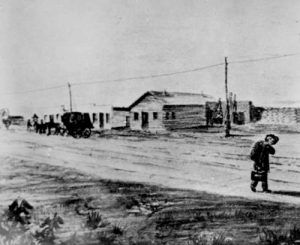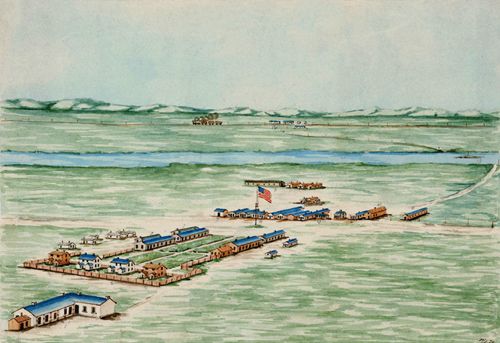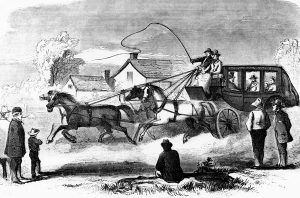Adventures and Tragedies on the Overland Trail – Legends of America (original) (raw)
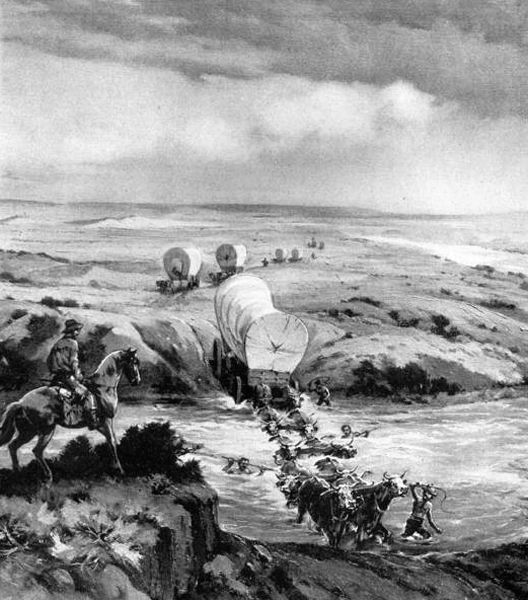
Santa Fe Trail Caravan.
By Randall Parrish in 1907
Sufferings from the Elements
The Santa Fe Trail was the first used for staging purposes and was also the first to be reddened with blood and witness the hardships of prairie travel. From the earliest attempts, accidents were frequent, and suffering from exposure to the elements was common. The terrible summer storms sweeping the level Plains or driving desert sand in clouds would delay the weary travelers for days in the utmost discomfort. Occasionally, the eight frisky mules would prove too much for their driver, and there would be a runaway and a broken coach to be repaired with whatever tools might be at hand. In wet weather, for mile after mile, the passengers might be compelled to plod beside the wheels, laboriously prying them out of the clinging mud and burdening the air with profanity.
However, the most serious disasters usually occur during the winter in the mountain district that is traversed before reaching Santa Fe. Being caught there by a raging snowstorm was undoubtedly a terrible experience. With the trail blotted entirely from sight, all that could be done was wait for the storm to blow over. Passengers and employees had to crowd into the coach and use every effort to keep from freezing, and in the end, they often found themselves minus mules with which to complete the journey. Yet, even more, a summer hailstorm was to be dreaded, for nowhere else do such ice chunks descend from the sky. Invariably, such a storm meant a stampede of the mules, nor would a man dare to desert his shelter to seek them.
A Massacre by Apache
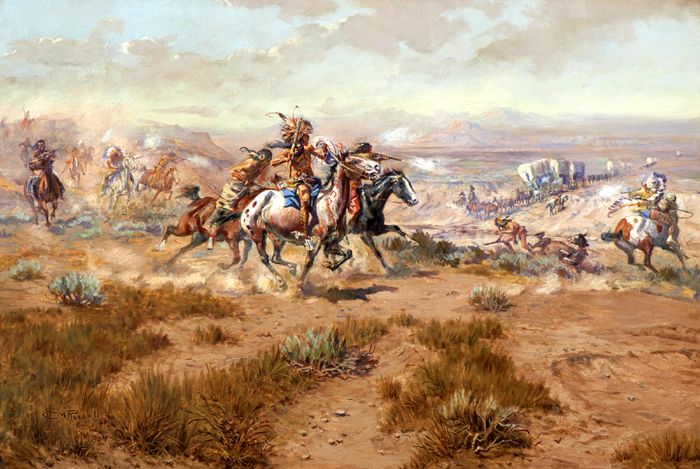
Indian Attack on a Wagon Train by Charles Marion Russell.
The first notable tragedy on the Santa Fe Trail connected to stage coaching occurred almost with the first effort to establish the line. It was a west-bound Concord, containing a full complement of passengers, including Mr. White, his wife, child, and a colored nurse. The journey was not an unpleasant one across the vast expanse of Plains. The Raton Range had been safely surmounted, and, just about dawn one morning, the heavy coach entered the canyon of the Canadian River, its occupants unsuspicious of any danger. Instantly, they were fiercely attacked by an ambushed party of Apache under White Wolf. With scarcely any opportunity for defense, the unfortunate whites were shot down, scalped, and their mutilated bodies left on the ground. Mrs. White, her child, and the nurse were borne away prisoners.
At Taos, New Mexico, were several troops of the Second Dragoons under Major Greer. The story of this outrage did not reach them for nearly two weeks, but upon its receipt, the Major at once started on a hard winter campaign in the hope of rescuing the captives. The soldiers had with them as guides several famous frontiersmen, Kit Carson, “Uncle Dick” Wootton, Joaquin Leroux, and Tom Tobin.
The heavy snow made trailing almost impossible, yet the scouts discovered “signs” and, amid much suffering, followed the Indian trail for nearly 400 miles and finally located the village. Everything was ready for a charge when Major Greer suddenly decided to talk with the Indians before commencing to fight. This decision greatly enraged the eager troopers and gave the Indians ample time to prepare for action. They took full advantage of the opportunity and poured in the first volley, Greer being struck in the breast, his life saved by a suspender buckle.
This occurrence took all desire for further peace talk from him, and the fight was on. The troopers charged twice, killing and wounding more than 100 Indians, but the chief escaped, and when the soldiers finally captured the village, they found there the body of Mrs. White, yet warm, with three arrows in her breast.
Fort Union, New Mexico, Kathy Alexander.
No trace of either the child or the colored nurse was ever found. White Wolf was killed later by Lieutenant David Bell, Second Dragoons, in a most dramatic manner and almost on the exact spot where the murders had been perpetrated. While on a scout with his troop from Fort Union, New Mexico, Bell came upon White Wolf and an equal number of Apache. As the conversation ensued, the controversy grew so heated that suddenly, the two leaders exchanged shots, the chief sinking on one knee to aim and Bell throwing his body forward and causing his horse to rear. [Colonel Henry Inman] describes what followed:
“Both lines by command fired, following the example of their superiors; the troopers, however, spurring forward over their enemies. The warriors, or nearly all of them, threw themselves on the ground, and the horse and rider received several vertical wounds. The dragoons turned short about and again charged through and over their enemies, the fire being continuous. As they turned for a third charge, the surviving Indians were seen escaping to a deep ravine, which, although only one or 200 paces off, had not previously been noticed. A number of the savages thus escaped, the troopers having to pull up at the brink but sending a volley after the descending fugitives. In less than 15 minutes, 21 of the 46 actors in this strange combat were slain or disabled. Bell was not hit, but four or five of his men were killed or wounded. He had shot White Wolf several times.”
Some Indian Leaders
George Bent.
In those early days of stage coaching on the Santa Fe Trail, the two most noted leaders of Indian raids were Satanta (White Bear), a chief of the Kiowa Nation, and George Bent, a half-breed desperado. In later years, Kicking Bird, also a Kiowa, became the terror of the Plains. The latter was finally poisoned by a Mexican woman in 1876. Santana had his headquarters in what is now known as the Cheyenne Bottoms, eight miles from the Great Bend of the Arkansas River and about the same distance from old Fort Zarah, Kansas. He was as cruel and heartless an Indian as ever, ambushed a stagecoach, and murdered helpless women. For 15 years, he was the terror of the Trail, and his acts of atrocity were incessant. George Bent had the famous Colonel William Bent of Bent’s Fort as a father, but his mother was a Cheyenne woman. Well-educated in St. Louis, Missouri, he no sooner returned to the Plains than he developed into a blood-thirsty desperado, organizing a body of young warriors, later known as “dog soldiers,” and beginning a series of depredations against the whites.
With over 100 men under him, he robbed ranches and attacked wagon trains, coaches, and army caravans. The history of his bloody deeds will never be told, for dead men tell no tales, and seldom did Bent leave any alive after a raid. From Walnut Creek to the mountains, no traveler was safe from attack by the “dog soldiers,” Often, a caravan started having the disguised George Bent as a guide, for his plans usually involved treachery. The Government offered $5,000 for his capture, dead or alive, but death finally came to him in the form of malarial fever.
Robbers, White and Red
Indian peril on the northern Overland route, while never wholly absent, grew most serious during the Civil War, when the Plains tribes became largely hostile. Road agents also became very much in evidence, and the robbery of stages was not uncommon. In July 1865, a stage carrying seven passengers and containing a considerable amount of gold bullion was the object of such an attack. The passengers were all old frontiersmen and were prepared for a desperate defense, anticipating a possible robbery attempt. But treachery worked their ruin. Beside the driver, named Frank Williams, sat one of the robbers, thoroughly disguised. At a lonely spot, this man suddenly shouted an alarm that the robbers were upon them. A shot was fired from beside the trail, and the men inside the coach instantly discharged their guns toward the supposed ambush. Immediately a regular volley was poured in from the opposite side; four of the passengers fell dead, another was severely wounded. Two men saved their lives, one feigning death in the bottom of the coach, the other escaping into the brush. The robbers secured over $70,000, and it was later discovered that the driver, Williams, was an accomplice and received his share. He was tracked to Denver, Colorado, and hanged with minimal ceremony.
StageStagecoachcked by Indians.
In 1862, the Indian raids on the coaches and stations between Fort Laramie and South Pass, Wyoming, were almost continuous. In April of that year occurred a terrible fight between the mail stage and Indians on the Sweetwater River. Two coaches were loaded with mail and nine men, the leaders being Lem Flowers, a division agent, and the conductor named Brown.
As was their custom, the Indians attacked at dawn, and the whites were compelled to run their coaches alongside each other, pile mail-sacks between the wheels, and throw sand over them for breastworks. Here, they fought their assailants all day, six of the men being wounded, and all their stock was driven off. Several Indians were killed, and at night, they withdrew, leaving the defenders to harness themselves to the running gear and thus draw their wounded comrades to safety. Another memorable raid was made all along the 200 miles between Julesburg, Colorado, and Liberty Farm, at the head of the Little Blue River in Nebraska, in August 1864. Mail coaches, freight caravans, ranches, and parties putting up hay were attacked simultaneously. More than 40 whites were killed, and the destruction of property was extensive.
Buffalo Bill, 1872.
Buffalo Bill as a Stage Driver
The route lying along the North Platte River became so dangerous that it was almost impossible to secure drivers, even at the highest wages. William F. Cody (Buffalo Bill) was a driver between Split Rock and Three Crossings, one of the most perilous sections. He had his full share of narrow escapes. Once, a band of several hundred Sioux set upon him. A Division Agent named Flowers was in the box with him, and half a dozen well-armed passengers were inside. When Cody saw the Indians, he handed the reins to Flowers and began applying the whip. There followed a hot running fight, the passengers firing from the coach windows and the Indian arrows flying thickly, wounding the horses, badly injuring Flowers, and killing two of the passengers. The others escaped after a hard run. In the Spring of 1865, the Plains tribes again became very troublesome and raided the stage line almost from end to end. Soldiers were used to guard the stagecoaches as attacks were frequent, and the loss of property and lives was significant. Passengers took their lives in their hands, and only the most daring and reckless men volunteered for the desperate service of driver or messenger.
Military Guards for Coaches
This custom of guarding coaches by soldiers along the Overland Trail was inaugurated during the Sioux uprising of 1863. George P. Belden, well known in those days as “The White Chief,” thus describes the disagreeable duties:
“Troops were stationed in small squads at every station, about ten miles apart, and they rode from station to station on the top of all coaches, holding their guns ever ready for action. It was not pleasant; this sitting perched up on top of a coach, riding through dark ravines and tall grass, in which savages were ever lurking. Generally, the first fire from the Indians killed one or two horses and tumbled a soldier or two off the top of the coach.
This setting oneself as a sort of target was a disagreeable and dangerous duty, but the soldiers performed it without murmuring. My squad had to ride up to Cottonwood River and down to the station below, where they waited for the next coach going the other way and returned by it to their post at Oilman’s. All the other stations were guarded like manner, so every coach carried some soldiers.”
Military Posts to Protect Settlements
Julesburg Station, Colorado.
A brief review of the operations of military scouting parties in the region of Julesburg, Colorado, which was the center of hostilities on the Plains and occasionally entirely cut off from communication, well illustrates the desperate nature of their duties. During 1863-65, the Sioux, Arapaho, and Cheyenne were all on the warpath. Not a mile of prairie between the upper Missouri River and the Arkansas River was safe for a white traveler. As early as 1860, trouble began after the beginning of emigration to Colorado and the discovery of gold in the Rocky Mountains. Troops occupied Bent’s Fort, and, in anticipation of coming events, several new posts were established throughout the Indian country and occupied by small garrisons. The breaking out of the Civil War required the withdrawal of many of the regulars from the Plains, and the Indians, quick to perceive their opportunity, began wholesale depredations. In 1862, the Sioux made a savage onslaught far east into Minnesota. The general uprising among the following tribes extended to the Rocky Mountains and even to the banks of the Columbia River. In numbers engaged, it attained the magnitude of war but was carried on in guerilla fashion.
The greater portion of the Plains country was then without permanent inhabitants, scarcely anything breaking the desolation excepting the isolated stations along the Overland and Santa Fe Trails, with a few scattered settlements extending into the prairies of Kansas and Nebraska. Though they occasionally attacked small bodies of troops, the Indians directed their primary efforts against the trains of freight wagons and the comparatively defenseless stage stations. Julesburg, Colorado, was the most important of these, situated in the heart of this blood-stained territory. This was the junction between the Overland mainline and the newly established branch leading to Denver. It was also the telegraph headquarters on the Plains, inaugurated in 1861.
Fort Sedgewick, Colorado.
Julesburg must have contained over 100 civilian inhabitants at this period, most of them employees of the stage company. As a protection for both lines, the Government later erected Fort Sedgwick on the South Fork of the Platte River. Julesburg was attacked on several occasions and, in February 1864, was burned to the ground. About 55 miles of the telegraph line were destroyed, stage stations razed, and employees killed for long distances east and west. At about the same time, a force of over 2,000 Indians made a determined attack upon a detachment of troops under Lieutenant-Colonel Collins at Rush Creek, Nebraska, 85 miles north of Julesburg. There followed a 24-hour fight, from which the whites emerged with a loss of but three men killed and eight wounded. Two months later, Collins was again in battle at Mud Springs, Nebraska, but succeeded in driving off his assailants.
As soon as Spring 1865 began to freshen the grass, the Indian tribes were again upon the warpath. In four weeks, they had killed and captured 45 whites between Sage Creek and Virginia Dale in Colorado. A combination of military forces compelled the allied tribes to make professions of peace and relieved the trail of its horror for a few months. It is easy to conceive the danger that night and day pursued those men who were employed on the Overland Trail. Never for a moment could they feel secure; every trip promised to be their last, and often, the coach dashed up to a station only to find it in ruins and surrounded by dead. The tales of suffering, desperate fighting, and incredible endurance cling to every mile from the Little Blue River to the Laramie River. The dead of those awful years lie numberless and nameless in their unknown, scattered graves.
By Randall Parrish, 1907. Compiled Kathy Alexander/Legends of America, updated April 2024.
Overland Stagecoach.
About the Author: Adventures and Tragedies on the Overland Trail was written by Randall Parrish as a chapter of his book, The Great Plains: The Romance of Western American Exploration, Warfare, and Settlement, 1527-1870; published by A.C. McClurg & Co. in Chicago, 1907. Parrish also wrote several other books, including When Wilderness Was King, My Lady of the North, Historic Illinois, and others. The text as it appears here, however, is not verbatim, as it has been edited for clarity and ease for the modern reader.
Also See:
Historical Accounts of American History

